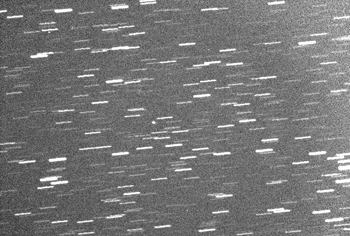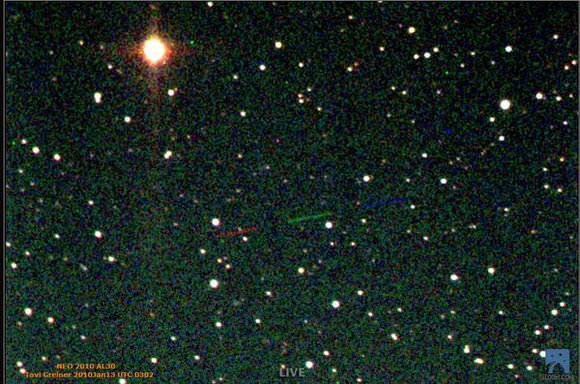[/caption]
Amateur astronomers heeded the call of making observations of the small asteroid 2010 AL30, which whizzed by Earth today. Here are some of the great images and videos captured by the amateur astronomy community, which will help the professionals determine the exact orbit, and also perhaps what exactly this unusual asteroid is. The object, which has been estimated to be between 10-15 meters (30 -50 feet) across, is likely a natural object, but it hasn't officially been ruled out that it might be man-made, i.e., a spent rocket booster, from perhaps the Venus Express mission. The folks who are apt to make the determination are those who work with the 70-meter radio dish at Goldstone. I corresponded with Lance Benner from the Goldstone facility, and he said, "We're still working with the data so it's still too early to say."
We'll keep you posted, but in the meantime, enjoy some of the images and videos of 2010 AL30's flyby. Above,
NASA Solar System Ambassador
Patrick Wiggins in Utah took a series of exposures and combined them into a "movie." He used a C-14 @ f/5.5 telescope and SBIG ST-10 binned 3×3 using a clear filter. The Field of View is about 18 x 26 arc minutes.
[caption id="attachment_50630" align="alignnone" width="564" caption="2010 AL30, on January 13, 2010. Credit: Ernesto Guido & Giovanni Sostero, Remanzacco Observatory. "]
[/caption]
This image was taken by 2010 AL30, on January 13, 2010 by Ernesto Guido & Giovanni Sostero, at the Remanzacco Observatory in Italy. Check out their website for more images.
The prospect of 2010 AL30 hitting Earth never even entered into the equation of this unusual asteroid. The problem, (if there is one) is that it was only detected two days ago. The other issue is its origin. The Italian astronomers who took the above image noted that the object has an orbital period of almost exactly one year and might be a man-made object. However, Alan Harris, senior researcher at the Space Science Institute countered by saying the object has a perfectly ordinary Earth-crossing orbit, and that its orbit doesn't resemble any useful spacecraft trajectory. Additionally, NASA put out a
press release yesterday saying the object was "a natural" asteroid.
"This object's orbit reaches the orbit of Venus at its closest point to the sun and nearly out to the orbit of Mars at its furthest point, crossing the Earth's orbit at a very steep angle," the press release said. "This makes it very unlikely that 2010 AL30 is a rocket stage. Furthermore, trajectory extrapolations show that this object cannot be associated with any recent launch and it has not made any close approaches to the Earth since well before the Space Age began."
continued below....
This is another video from Patrick Wiggins, this time with a smaller exposure time. "The target is pretty faint (not surprising for 1" exposures) so you have to look close to see it as it moves from left to right," he said. (Thanks to the SciBuff website for the video.)
But then, ESA mission analyst Michael Khan looked at data from the Venus Express mission,
and he wrote in his blog
that perhaps 2010 AL30 might be the Fregat upper stage of the rocket that sent Venus Express to Venus. Only more detailed analysis of data from the object will provide the answer.
This image was taken by Tavi Greiner, using the SLOOH robotic observatory on the Canary Islands, at 03:02 GMT. Check out SLOOH to find out how you can take your own images.
The initial word from Goldstone is that the object produced very strong radar echoes, and also that it had a very fast 9-minute rotation.
[caption id="attachment_50633" align="alignnone" width="580" caption="The trajectory of 2010 AL30. Credit: NASA's NEO program"]
[/caption]
The trajectory of 2010 AL30.
2010 AL30 imaged on January 12 from the distance of 0.003 7 AU at the Nazaret Observatory at the Canary Islands - Credit: Gustavo, Muler, Schteinman - Observatorio Nazaret, J47. Click on the image or here to see a "movie" of the object.
Check out more images on
Spaceweather.com,
including
this image from
Alberto Quijan Vodniza and Mario Rojas Pereira from the University of Narino- Columbia.
There's also this very cool animation of 2010 AL30's approach, and what Earth would look like to anyone "riding" on the asteroid.
Also, check out the
Transient Sky blog, where Carl Hergenrother
lays out the details what might have happened if 2010 AL30 had been headed for impact with Earth.
And one more thing, via the
Bad Astronomer,
is this great graphic showing how
far
away this object passed by Earth.
Sources: SciBuff,
Emily Lakdawalla's Planetary Blog
,
Spaceweather.com
,
Transient Sky
 Universe Today
Universe Today

